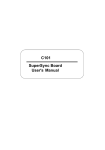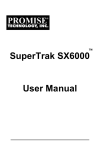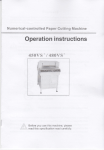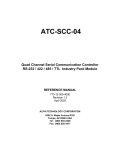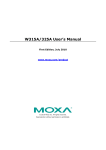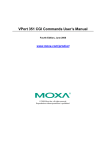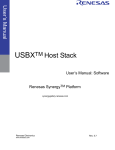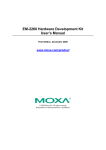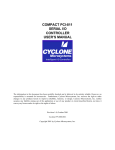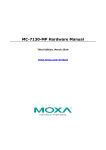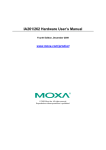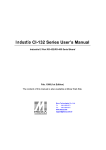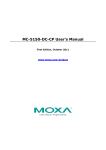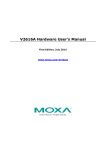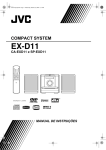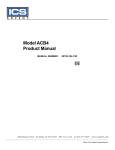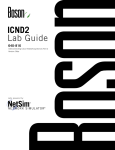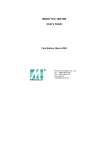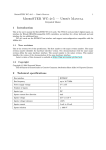Download C101 ISA/PCI SuperSync Board User`s Manual
Transcript
C101 ISA/PCI SuperSync Board User’s Manual Second Edition, November 2001 Moxa Technologies Co., Ltd. Tel: +866-2-8919-1230 Fax: +886-2-8919-1231 www.moxa.com [email protected] C101 ISA/PCI SuperSync Board User’s Manual The software described in this manual is furnished under a license agreement and may be used only in accordance with the terms of that agreement. Copyright Notice Copyright 2001 Moxa Technologies Co., Ltd. All rights reserved. Reproduction without permission is prohibited. Trademarks MOXA is a registered trademark of Moxa Technologies Co., Ltd. All other trademarks or registered marks in this manual belong to their respective manufacturers. Disclaimer Information in this document is subject to change without notice and does not represent a commitment on the part of Moxa. Moxa provides this document “as is”, without warranty of any kind, either expressed or implied, including, but not limited to, its particular purpose. Moxa reserves the right to make improvements and/or changes to this manual, or to the products and/or the programs described in this manual, at any time. Information provided in this manual is intended to be accurate and reliable. However, Moxa Technologies assumes no responsibility for its use, or for any infringements on the rights of fourth parties that may result from its use. This product might include unintentional technical or typographical errors. Changes are periodically made to the information herein to correct such errors, and these changes are incorporated into new editions of the publication. MOXA Internet Services Customer satisfaction is our number one concern. To ensure that customers receive the full benefit of our products, Moxa Internet Services has been set up to provide technical support, driver updates, product information, and user’s manual updates. The following services are provided E-mail for technical support: ……………………………… [email protected] FTP site for free driver updates: ………………………….. ftp://ftp.moxa.com or …………….………………….……… ftp://ftp.moxa.com.tw user ID: ……………………………… ftp password: ……………………………. your_email_address World Wide Web (WWW) Site for product information: ……………………………………….. http://www.moxa.com …………………………………..….… http://www.moxa.com.tw or Table of Contents Chapter 1 Introduction ...............................................................................1-1 Overview ...................................................................................................................... 1-2 Features ........................................................................................................................ 1-2 Specifications................................................................................................................ 1-2 Package Checklist ......................................................................................................... 1-3 Chapter 2 Hardware Installation................................................................2-1 C101/ISA Hardware Installation.................................................................................... 2-2 C101/PCI Hardware Installation.................................................................................... 2-5 Chapter 3 Software Installation .................................................................3-1 Windows NT................................................................................................................. 3-2 MS-DOS ..................................................................................................................... 3-17 Chapter 4 PIN Assignments and Cable Wiring.........................................4-1 C101/ISA Pin Assignments........................................................................................... 4-2 C101/PCI Pin Assignments ........................................................................................... 4-4 1 1 Introduction Welcome to the Moxa C101 SuperSync Board Family, designed to provide efficient and cost-effective synchronous serial communications. This chapter introduces the features and appearance of C101 and includes the following sections. q Overview q Features q Specifications q Package Checklist C101 ISA/PCI SuperSync Board User’s Manual 1-1 Overview The C101 SuperSync Board Family consists of two products, an ISA board and a PCI board, both of which provide programmers with a cost-effective asynchronous communications solution. These boards have one programmable RS-232 port, and are able to connect to a wide range of hosts using either public or proprietary communications protocols. The C101 boards use the Hitachi HD64570 SCA (Serial Communications Adapter) chip, which is a highly integrated communications subsystem, and includes a sync port, built-in DMA controller, 32 byte FIFO, and interrupt and timer logic. DMA (Direct Memory Access) technology also helps the C101 boards lower system overhead while boosting data transmission speed up to 4 Mbps. Onboard dual-ported memory is directly addressable by both the system and SCA’s DMA. Features q Powerful Hitachi HD64570 serial communications adapter q Sync I/O rate up to 4 Mbps for V.35, or 128 Kbps for RS-232 q V.35/RS-232 selectable interface q PCI or ISA bus available q Supports HDLC, SDLC, BSC, developer’s tool q Supports Windows NT, DOS, Linux (PPP) q Supports C/C++, Visual Basic, and Delphi programming library q Supports both Bit Sync and Byte Sync Specifications q I/O controller q Memory q Bus PCI ver. 2.1 (32 bit) or ISA (16 bit) q No. of ports One sync port q Sync interface RS-232/V.35 interface selectable q Speed 4 Mbps (V.35); 128 Kbps (RS-232) Hitachi HD 64750 USART Serial Communication Adapter with DMA Controller PCI: 512 KB dual-ported RAM ISA: 256 KB dual-ported RAM 1-2 C101 ISA/PCI SuperSync Board User’s Manual Introduction q Max. No. of ports 4 (4 boards per Windows NT, Linux, and DOS systems) 1 (1 board per Windows 3.x system) q IRQ PCI: Assigned by BIOS ISA: 2, 3, 4, 5, 7, 10 (default), 11, 12 or 15 (jumper selectable) q Transmit Clocking PCI: Assigned by BIOS ISA: Internal/External (jumper selectable) q Power requirements 555 mA (5V); 19 mA (+12V); 23 mA (-12V) q Operating temp. 0 − 55℃ q Dimensions PCI: 135 × 100 mm (W×D) ISA: 160 × 92 mm (W×D) q Package weight 0.3 kg q Regulatory approvals FCC, CE Package Checklist C101 SuperSync Boards are shipped with the following items. If any of these items is missing or damaged, please contact your customer service representative for assistance. q C101 SuperSync Board (ISA or PCI) q Software CD q User’s Manual q MOXA Product Warranty booklet C101 ISA/PCI SuperSync Board User’s Manual 1-3 2 2 Hardware Installation This chapter includes instructions on how to install the C101 SuperSync board in your PC. q C101/ISA Hardware Installation q C101/PCI Hardware Installation C101 ISA/PCI SuperSync Board User’s Manual 2-1 C101/ISA Hardware Installation The C101/ISA SuperSync board is an asynchronous serial communications board that uses onboard jumpers and DIP switches to configure the board’s essential operation parameters. You may refer to the following sections to learn how to configure the C101/ISA board’s base address, IRQ number, interface type, and clock direction. Note that this configures the board itself. As we will see in the next chapter, each of these items must also be configured on the software side of the board’s operation after the driver is installed. Base Address The base address is the memory address of the first byte of a 16 KB window, located in your PC’s memory, that is used during the operation of C101/ISA. The base address is set using 5 DIP switches located next to the board’s serial connector, as shown in the following photograph. Note that down is the DIP switch’s ON position. There are six base addresses from which to choose (see table below). Choose an address not being used by the expansion memory or other add-on cards. Note that if you want to add more than one C101/ISA board, each board must use a different IRQ number. DIP Switch No. default à DIP Switch Setting 2-2 1 2 3 4 5 Base Address ON ON ON ON ON ON ON ON OFF OFF OFF ON ON OFF ON 0xC8000 0xCC000 0xD0000 ON ON OFF ON OFF 0xD4000 ON ON OFF OFF ON 0xD8000 ON ON OFF OFF OFF 0xDC000 C101 ISA/PCI SuperSync Board User’s Manual Hardware Installation IRQ Number The IRQ number, in which IRQ stands for interrupt request, is used to inform the PC’s operating system which device is requesting its attention. There are 9 choices of IRQ (2, 3, 4, 5, 7, 10, 11, 12, and 15), with the board’s IRQ number configured using Jumper 1 (JP1), as shown in the adjacent photograph. The factory default is 10. Clock Direction The C101/ISA board supports two transmit clock modes: OUT and IN. This applies to the situation when the C101 board is transmitting (as opposed to receiving) data. Choosing mode OUT means that the board supplies the clock while transmitting data, whereas choosing mode IN means the device that is receiving data from the C101 board supplies the clock. The transmit clock direction is set using Jumper 2 (JP2), as shown in the photo. The factory default is OUT. Interface Type The C101/ISA board supports two interface types: RS-232 and V.35. Use Jumper 3 (JP3) to select which interface type is used, as shown in the photo. Note that the C101/ISA board comes with an RS-232/DB25 serial port. When using V.35, the user must attach an RS-232/DB25 to V.35 cable. The factory default is V.35. C101 ISA/PCI SuperSync Board User’s Manual 2-3 C101/ISA Hardware Installation Procedure The following steps give the procedure for installing the C101/ISA board in your computer. The procedure is simple and straightforward, but as with any sensitive electronic equipment, care must be taken not to damage the board, or the computer in which it is being installed. 1. Power off the PC and remove the PC cover. 2. Configure the C101/ISA board’s — Base address — IRQ number — Clock direction — Interface type as outlined in the previous section. 2-4 3. Locate an available 16-bit ISA expansion slot. Remove the slot’s retaining screw and put it aside. 4. Remove the ISA expansion slot’s cover. 5. Orient the C101/ISA board’s connector edge so that it is facing downwards, and then place the connector edge into the I/O slot. Press the board firmly until it snaps into the plastic edge connector socket on the computer’s motherboard. 6. Use the retaining screw to secure the C101/ISA board to the PC’s rear panel. 7. Replace the PC cover. C101 ISA/PCI SuperSync Board User’s Manual Hardware Installation C101/PCI Hardware Installation The C101/PCI SuperSync board is an intelligent asynchronous serial communications board (i.e., it has a built-in CPU). There are no onboard jumpers or DIP switches, which means that installing the PCI board involves simply inserting the board into an empty PCI slot. C101/PCI Hardware Installation Procedure The following steps give the procedure for installing the C101/PCI board in your computer. The procedure is simple and straightforward, but as with any sensitive electronic equipment, care must be taken not to damage the board, or the computer in which it is being installed. 1. Power off the PC and remove the PC cover. 2. Locate an available 32-bit PCI expansion slot. Remove the slot’s retaining screw and put it aside. 3. Remove the PCI expansion slot’s cover. 4. Orient the C101/PCI board’s connector edge so that it is facing downwards, and then place the connector edge into the I/O slot. Press the board firmly until it snaps into the plastic edge connector socket on the computer’s motherboard. 5. Use the retaining screw to secure the C101/PCI board to the rear panel. 6. Replace the PC cover. Installing Additional Boards You may repeat the above procedure to install additional boards in the same computer, with a maximum of four C101/ISA and/or C101/PCI boards allowed per computer. C101 ISA/PCI SuperSync Board User’s Manual 2-5 3 3 Software Installation This chapter includes instructions on how to install the drivers used to control your C101 SuperSync Boards. q Windows NT q MS-DOS C101 ISA/PCI SuperSync Board User’s Manual 3-1 Windows NT Moxa provides Windows NT drivers for both the C101/ISA and C101/PCI boards. C101 Windows NT Driver Installation Follow these simple steps to install the Windows NT driver for both the C101/ISA and C101/PCI boards. 3-2 1. Insert the software CD into your computer’s CD ROM drive. 2. From the NT desktop, click on Start and then select Run. 3. Click on Browse… and then find the ssnt12.exe program located on the software CD. Click OK to run the setup program. C101 ISA/PCI SuperSync Board User’s Manual Software Installation 4. The Welcome! window opens next. Click on Next to proceed with the installation. 5. The Select Destination Directory window opens next. Click on Next to install the driver software in the default directory, or click on Browse… to specify a different folder. C101 ISA/PCI SuperSync Board User’s Manual 3-3 3-4 6. The Ready to Install! window opens next. Click on Next to proceed with the installation. 7. The Installing window indicates the progress of the installation procedure. The time required to install varies, but should take at most several seconds. C101 ISA/PCI SuperSync Board User’s Manual Software Installation 8. The Installation Completed! window opens next. Click on Finish to complete the installation. The next step is to configure the driver to work correctly with your C101 boards. The following two sections explain how to configure the C101/ISA and C101/PCI boards, respectively. C101 ISA/PCI SuperSync Board User’s Manual 3-5 C101/ISA Board Configuration It is essential that parameters configured using the board’s configuration utility be set up in exactly the same way as was done when setting jumpers and DIP switches. The figures in this section were generated with only one C101/ISA card installed in the PC. The figures may look somewhat different if more than one C101/ISA card is installed, or one or more C101/PCI cards are installed, but the configuration procedure is the same. 3-6 1. Either continue from the C101 Windows NT Driver Installation section, or click on Start à Programs à Moxa C101 Sync Board (V-1.2) à Configure C101 to start the C101 configuration utility. 2. The Moxa C101 configuration window opens, as shown below. C101 ISA/PCI SuperSync Board User’s Manual Software Installation 3. Choose the Port Number (8, 9, 10, or 11) that you intend to associate with your C101/ISA board, and then click on the drop down button under that number located to the right of Board Type. In this example, we associate Port Number 8 with the installed C101/ISA board. Position the cursor over C101/ISA, and then press the left mouse button. C101 ISA/PCI SuperSync Board User’s Manual 3-7 4. Certain default values will appear in the Memory bank, Tx clock direction, IRQ number, and Operation mode slots under the chosen Port Number. WARNING: These values may be different from the board values that were set using jumpers and DIP switches during the Hardware Installation procedure discussed in Chapter 2. You must take care to set up the same values while carrying out the software configuration procedure described below. 5. 3-8 Click on the drop down button to the right of Memory bank, position the cursor over the correct value (0xC8000, 0xCC000, 0xD0000, 0xD4000, 0xD8000, or 0xDC000), and then press the left mouse button to choose that value. C101 ISA/PCI SuperSync Board User’s Manual Software Installation 6. Click on the drop down button to the right of TX clock direction, position the cursor over the correct value (Out or In), and then press the left mouse button to choose that value. 7. Click on the drop down button to the right of IRQ number, position the cursor over the correct value (2, 3, 4, 5, 7, 10, 11, 12, or 15), and then release the left mouse button to choose that value. C101 ISA/PCI SuperSync Board User’s Manual 3-9 3-10 8. Click on the drop down button to the right of Operation mode, position the cursor over the correct value (HDLC, Mono-Sync, or Bi-Sync), and then press the left mouse button to choose that value. 9. The Moxa C101 configuration window will display the selected values for your C101/ISA board. Click OK to accept these values. C101 ISA/PCI SuperSync Board User’s Manual Software Installation 10. The following Warning! window will open to remind you to double check that the configuration parameters you have selected should match those set using jumpers and DIP switches. Click OK to configure 11. You will be prompted to reboot the operating system. Click OK to reboot, or Cancel to postpone the reboot until a later time. C101 ISA/PCI SuperSync Board User’s Manual 3-11 C101/PCI Board Configuration The C101/PCI board is an example of what is often referred to as an “intelligent” board. This is due to the fact that it has an on-board CPU that takes care of some of the data transmission tasks. Compared to the ISA board, there are fewer user-configured parameters, since many of the parameter values are automatically set by the operating system on boot-up. The figures in this section were generated with only one C101/PCI card installed in the PC. The figures may look somewhat different if more than one C101/PCI card is installed, or one or more C101/ISA cards are installed, but the configuration procedure is the same. 1. 3-12 Either continue from the C101 Windows NT Driver Installation section, or click on Start à Programs à Moxa C101 Sync Board (V-1.2) à Configure C101 to start the C101 configuration utility. C101 ISA/PCI SuperSync Board User’s Manual Software Installation 2. A free Port Number will automatically be assigned to the C101/PCI board. In the example shown here, Port Number 8 is assigned. 3. To choose a different Port Number, first click on the Board type pull down button for the currently selected Port Number, and select None. Next, click on the Board type pull down button under the desired Port Number, and select C101/PCI. C101 ISA/PCI SuperSync Board User’s Manual 3-13 3-14 4. Click on the drop down button to the right of Slot Number to choose the Slot Number for the board. If only one C101/PCI board is installed then there will only be one choice for this parameter. 5. Click on the drop down button to the right of Operation Mode to choose the correct value (HDLC, Mono-Sync, or Bi-Sync). C101 ISA/PCI SuperSync Board User’s Manual Software Installation 6. Click OK to accept the displayed configuration parameters. 7. You will be prompted to reboot the operating system. Click OK to reboot, or Cancel to postpone the reboot until a later time. C101 ISA/PCI SuperSync Board User’s Manual 3-15 Uninstalling the C101 Driver Moxa provides a convenient Uninstall program that can be used to completely remove the C101 driver software from your system. Use the following procedure to uninstall the driver software. 3-16 1. From the Windows NT desktop, click on Start à Programs à Moxa C101 Sync Board (V-1.2) à Uninstall C101. 2. Select Automatic to completely remove the driver software, or select Custom to remove portions of it, or to make certain modifications. C101 ISA/PCI SuperSync Board User’s Manual Software Installation 3. Click on Finish to complete the uninstall procedure. MS-DOS Moxa provides an MS-DOS driver and convenient configuration utility for the C101/ISA board. C101/ISA MS-DOS Driver Installation 1. Create a directory on your computer’s hard disk. You may choose whatever name you wish for the directory—in the following example, we use the name C101DOS. 2. Copy all the contents (files and folders) of the C101 Dos folder from the software CD to folder C101DOS just created on your hard drive. Check the contents of the C101DOS folder to make sure it contains the following: Bin Example Lib Readme 3. [subdirectory] [subdirectory] [subdirectory] [file] You must work from “real DOS mode”. If necessary, shut down your NT system and then reboot under real DOS mode. C101 ISA/PCI SuperSync Board User’s Manual 3-17 4. Run the program SETUP.EXE (located in the Bin subdirectory) from the MS-DOS prompt. The program is run by typing setup to the right of the MS-DOS prompt. Note that you may need to first use the Change Directory (CD) command to switch to the Bin subdirectory, as shown below. C:\>CD C101DOS C:\C101DOS>CD BIN C:\C101DOS\BIN>setup 5. If you are installing the board for the first time under MS-DOS, then you should see the following window. Use the left/right arrow keys to highlight the None under the desired Board No., and then press Enter. Board No. Board Type Start Port Memory Bank Irq 6. 02 03 04 A small selection window will open. Use the down arrow to highlight C101/ISA, and then press Enter to select this option. Board No. Board Type Start Port Memory Bank Irq 3-18 01 01 02 03 04 C101 ISA/PCI SuperSync Board User’s Manual Software Installation 7. The setup program will automatically assign values to Start Port, Memory Bank, and Irq. WARNING: These values may be different from the board values that were set using jumpers and DIP switches during the Hardware Installation procedure discussed in Chapter 2. You must take care to set up the same values while carrying out the software configuration procedure described here. Board No. Board Type Start Port Memory Bank Irq 8. 01 02 03 04 To change the Start Port value, use the down arrow to highlight the value to the right of Start Port, and then press Enter to open the following options window. Board No. Board Type Start Port 01 02 03 04 Memory Bank Irq 9. Use the left/right and up/down arrow keys to select the desired number, and then press Enter to accept the value. Board No. Board Type Start Port Memory Bank Irq 01 02 03 04 C101 ISA/PCI SuperSync Board User’s Manual 3-19 10. To change the Memory Bank value, use the down arrow to highlight the value to the right of Memory Bank, and then press Enter to open the following options window. Board No. Board Type Start Port Memory Bank Irq 01 02 03 04 11. Use the left/right and up/down arrow keys to select the desired number, and then press Enter to accept the value. Board No. Board Type Start Port Memory Bank Irq 01 02 03 04 12. To change the Irq value, use the down arrow to highlight the value to the right of Irq, and then press Enter to open the following options window. Board No. Board Type Start Port Memory Bank Irq 3-20 01 02 03 04 C101 ISA/PCI SuperSync Board User’s Manual Software Installation 13. Use the up/down arrow key to highlight the desired value, and then press Enter to accept this value. Board No. Board Type Start Port Memory Bank Irq 01 02 03 04 14. At this point, you will need to set up the port’s Tx Clock Dir and Operation mode parameters. To do this, press the F7 key, in which case the Tx Clock Dir parameter will be highlighted. Board No. Tx Clock Dir Operation mode 01 02 03 04 15. Press Enter to display the following selection window. Use the up/down arrow to select the desired value, and then press Enter to select the value. Board No. Tx Clock Dir Operation mode 01 02 03 04 16. To change the Operation mode, use the down arrow to highlight the value to the right of Operation mode and then press Enter to open the following selection window. Board No. Tx Clock Dir Operation mode 01 02 03 04 C101 ISA/PCI SuperSync Board User’s Manual 3-21 17. Use the up/down arrow to choose either HDLC, Mono-Sync, or Bi-Sync, and then press Enter to select that option. Board No. Tx Clock Dir Operation mode 01 02 03 04 18. The final step is to run the program C101-DRV.EXE from the DOS prompt to TSR the driver. The program is run by typing C101-DRV to the right of the MS-DOS prompt. Note that you may need to first use the Change Directory (CD) command to switch to the Bin subdirectory, as shown below. C:\>CD C101DOS C:\C101DOS>CD BIN C:\C101DOS\BIN>C101-DRV . NOTE: After you TSR the driver, you may include ‘syncapi.h’ and ‘syio_cX.lib’ in your programs, and use the associated library functions. 3-22 C101 ISA/PCI SuperSync Board User’s Manual 4 4 PIN Assignments and Cable Wiring This chapter includes pin assignment diagrams, and instructions on how to make your own cables q Pin Assignments q Cable Wiring C101 ISA/PCI SuperSync Board User’s Manual 4-1 C101/ISA Pin Assignments DB25 Interface (NOTE: This is the standard RS-232 interface.) 4-2 Pin Signal Direction 2 TxD Out 3 RxD In 4 RTS Out 5 CTS In 6 DSR In 7 GND --- 20 DTR Out 8 DCD In 24 TxC Out 15 TxC In 17 RxC In C101 ISA/PCI SuperSync Board User’s Manual PIN Assignments and Cable Wiring V.35 Interface (ISA) DB25 Signal Pin V.35 Pin Direction 2 TxDA P Out 14 TxDB S Out 3 RxDA R In 16 RxDB T In 15 TxCA Y In 13 TxCB AA In 24 TxCA Y Out 23 TxCB AA Out 17 RxCA V In 19 RxCB X In 4 RTS C Out 5 CTS D In 20 DTR H Out 6 DSR E In 8 DCD F In 7 GND B --- C101 ISA/PCI SuperSync Board User’s Manual 4-3 C101/PCI Pin Assignments DB25 Connector (NOTE: This is the standard RS-232 interface.) 4-4 Pin Signal Direction 2 TxD Out 3 RxD In 4 RTS Out 5 CTS In 6 DSR In 7 GND --- 20 DTR Out 8 DCD In 24 TxC Out 15 TxC In 17 RxC In 25 232EN floating C101 ISA/PCI SuperSync Board User’s Manual PIN Assignments and Cable Wiring V.35 Interface (PCI) DB25 Pin Signal V.35 Pin Direction 11 TxDA P Out 10 TxDB S Out 13 RxDA R In 12 RxDB T In 16 TxCA Y In 14 TxCB AA In 21 TxCA Y Out 19 TxCB AA Out 23 RxCA V In 22 RxCB X In 4 RTS C Out 5 CTS D In 20 DTR H Out 6 DSR E In 8 DCD F In 7 GND B --- 25 232EN 9 GND Short for V.35 C101 ISA/PCI SuperSync Board User’s Manual 4-5 Problem Report Form C101 ISA/PCI SuperSync Board Customer name: Company: Tel: Fax: Email: Date: 1. Moxa Product: o C101/ISA 2. Serial Number: ___________ 3. C101 Firmware Version: 4. DSU/CSU: Make____________Model_________ Make _________ 5. PC Host: 6. CPU: 7. Ethernet Card : Speed _____MHz o C101/PCI ________________ Model _________ Make ______ Model ____ o ISA Card Make__________ o PCI Card Make: __________ Problem Description: Please describe the symptoms of the problem as clearly as possible, including any error messages you see. We may have to follow your description to reproduce the symptoms, so please give a complete description of the problem. RETURN PROCEDURE For product repair, exchange, or refund, the customer must: — Provide evidence of original purchase. — Obtain a Product Return Agreement (PRA) from the sales representative or dealer. — Fill out the Problem Report Form (PRF). Include as much detail as possible for a shorter product repair time. — Carefully pack the product in an anti-static package, and send it, pre-paid, to the dealer. The PRA should be visible on the outside of the package, and include a description of the problem, along with the return address and telephone number of a technical contact.












































